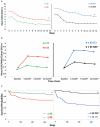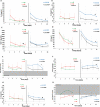Older Adults Demonstrate Biomarker Evidence of the Persistent Inflammation, Immunosuppression, and Catabolism Syndrome (PICS) After Sepsis
- PMID: 33721883
- PMCID: PMC8751807
- DOI: 10.1093/gerona/glab080
Older Adults Demonstrate Biomarker Evidence of the Persistent Inflammation, Immunosuppression, and Catabolism Syndrome (PICS) After Sepsis
Abstract
Background: Hospital deaths after sepsis have decreased substantially and most young adult survivors rapidly recover (RAP). However, many older survivors develop chronic critical illness (CCI) with poor long-term outcomes. The etiology of CCI is multifactorial and the relative importance remains unclear. Sepsis is caused by a dysregulated immune response and biomarkers reflecting a persistent inflammation, immunosuppression, and catabolism syndrome (PICS) have been observed in CCI after sepsis. Therefore, the purpose of this study was to compare serial PICS biomarkers in (i) older (vs young) adults and (ii) older CCI (vs older RAP) patients to gain insight into underlying pathobiology of CCI in older adults.
Method: Prospective longitudinal study with young (≤45 years) and older (≥65 years) septic adults, who were characterized by (i) baseline predisposition, (ii) hospital outcomes, (iii) serial Sequential Organ Failure Assessment (SOFA) organ dysfunction scores over 14 days, (iv) Zubrod Performance status at 3-, 6-, and 12-month follow-up, and (v) mortality over 12 months, was conducted. Serial blood samples over 14 days were analyzed for selected biomarkers reflecting PICS.
Results: Compared to the young, more older adults developed CCI (20% vs 42%) and had markedly worse serial SOFA scores, performance status, and mortality over 12 months. Additionally, older (vs young) and older CCI (vs older RAP) patients had more persistent aberrations in biomarkers reflecting inflammation, immunosuppression, stress metabolism, lack of anabolism, and antiangiogenesis over 14 days after sepsis.
Conclusion: Older (vs young) and older CCI (vs older RAP) patient subgroups demonstrate early biomarker evidence of the underlying pathobiology of PICS.
Keywords: Aging; Chronic critical illness; Critical illness; Infection.
© The Author(s) 2021. Published by Oxford University Press on behalf of The Gerontological Society of America. All rights reserved. For permissions, please e-mail: journals.permissions@oup.com.
Figures




Similar articles
-
Biomarker Evidence of the Persistent Inflammation, Immunosuppression and Catabolism Syndrome (PICS) in Chronic Critical Illness (CCI) After Surgical Sepsis.Ann Surg. 2021 Oct 1;274(4):664-673. doi: 10.1097/SLA.0000000000005067. Ann Surg. 2021. PMID: 34506322 Free PMC article.
-
Abdominal sepsis patients have a high incidence of chronic critical illness with dismal long-term outcomes.Am J Surg. 2020 Dec;220(6):1467-1474. doi: 10.1016/j.amjsurg.2020.07.016. Epub 2020 Jul 25. Am J Surg. 2020. PMID: 32807383 Free PMC article.
-
Benchmarking clinical outcomes and the immunocatabolic phenotype of chronic critical illness after sepsis in surgical intensive care unit patients.J Trauma Acute Care Surg. 2018 Feb;84(2):342-349. doi: 10.1097/TA.0000000000001758. J Trauma Acute Care Surg. 2018. PMID: 29251709 Free PMC article.
-
Innate Immunity in the Persistent Inflammation, Immunosuppression, and Catabolism Syndrome and Its Implications for Therapy.Front Immunol. 2018 Apr 4;9:595. doi: 10.3389/fimmu.2018.00595. eCollection 2018. Front Immunol. 2018. PMID: 29670613 Free PMC article. Review.
-
Dysregulated Immunity and Immunotherapy after Sepsis.J Clin Med. 2021 Apr 17;10(8):1742. doi: 10.3390/jcm10081742. J Clin Med. 2021. PMID: 33920518 Free PMC article. Review.
Cited by
-
Identification of biomarkers and the mechanisms of multiple trauma complicated with sepsis using metabolomics.Front Public Health. 2022 Aug 4;10:923170. doi: 10.3389/fpubh.2022.923170. eCollection 2022. Front Public Health. 2022. PMID: 35991069 Free PMC article.
-
Biomarkers of neuropsychiatric dysfunction in intensive care unit survivors: a prospective cohort study.Crit Care Sci. 2023 Apr-Jun;35(2):147-155. doi: 10.5935/2965-2774.20230422-en. Crit Care Sci. 2023. PMID: 37712803 Free PMC article.
-
The Tri-Steps Model of Critical Conditions in Intensive Care: Introducing a New Paradigm for Chronic Critical Illness.J Clin Med. 2024 Jun 24;13(13):3683. doi: 10.3390/jcm13133683. J Clin Med. 2024. PMID: 38999249 Free PMC article.
-
Immunometabolic features of natural killer cells are associated with infection outcomes in critical illness.Front Immunol. 2024 Feb 15;15:1334882. doi: 10.3389/fimmu.2024.1334882. eCollection 2024. Front Immunol. 2024. PMID: 38426112 Free PMC article.
-
Risk factors, biomarkers, and mechanisms for persistent inflammation, immunosuppression, and catabolism syndrome (PICS): a systematic review and meta-analysis.Br J Anaesth. 2024 Sep;133(3):538-549. doi: 10.1016/j.bja.2024.03.038. Epub 2024 Apr 30. Br J Anaesth. 2024. PMID: 38688799 Free PMC article.
References
-
- Martin GS, Mannino DM, Moss M. The effect of age on the development and outcome of adult sepsis. Crit Care Med. 2006;34:15–21. doi:10.1097/01.ccm.0000194535.82812.ba - DOI - PubMed
Publication types
MeSH terms
Substances
Grants and funding
LinkOut - more resources
Full Text Sources
Other Literature Sources
Medical

